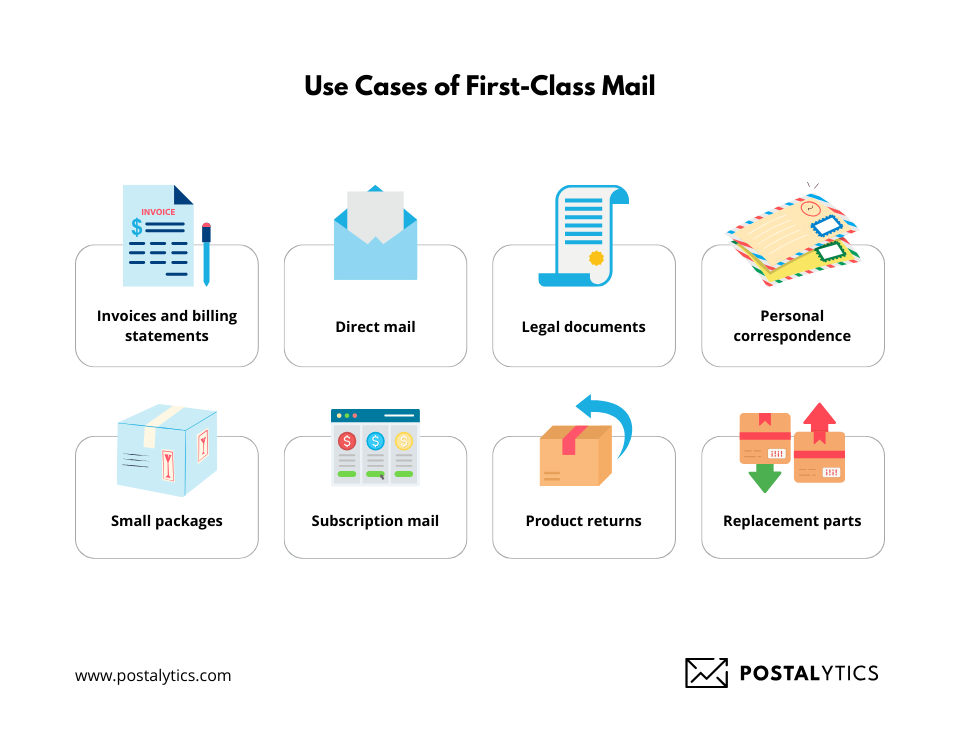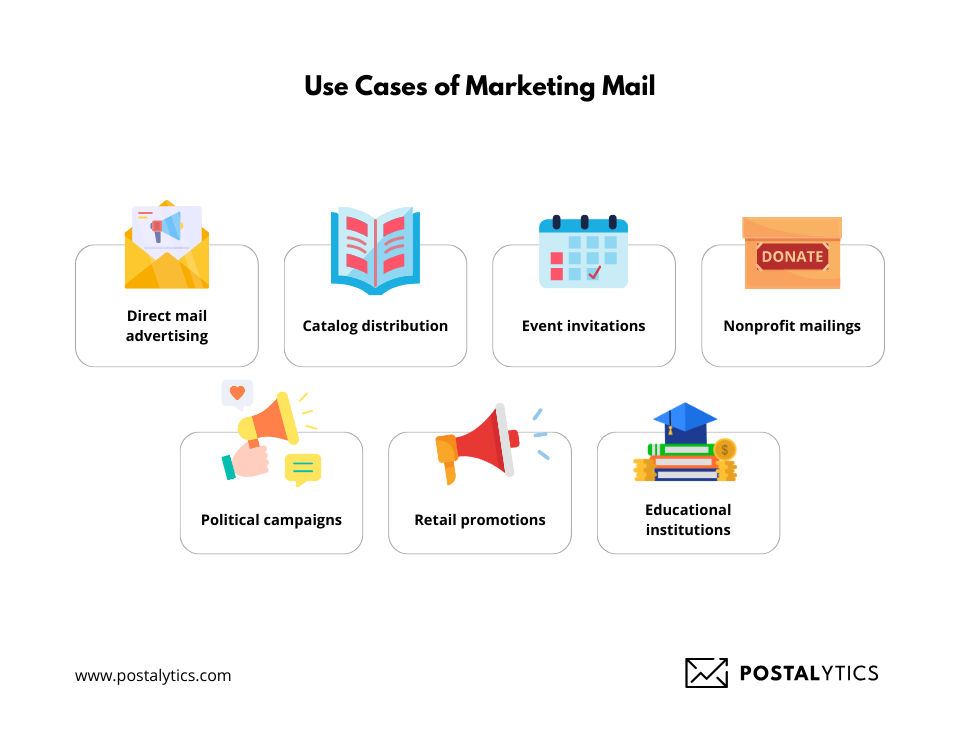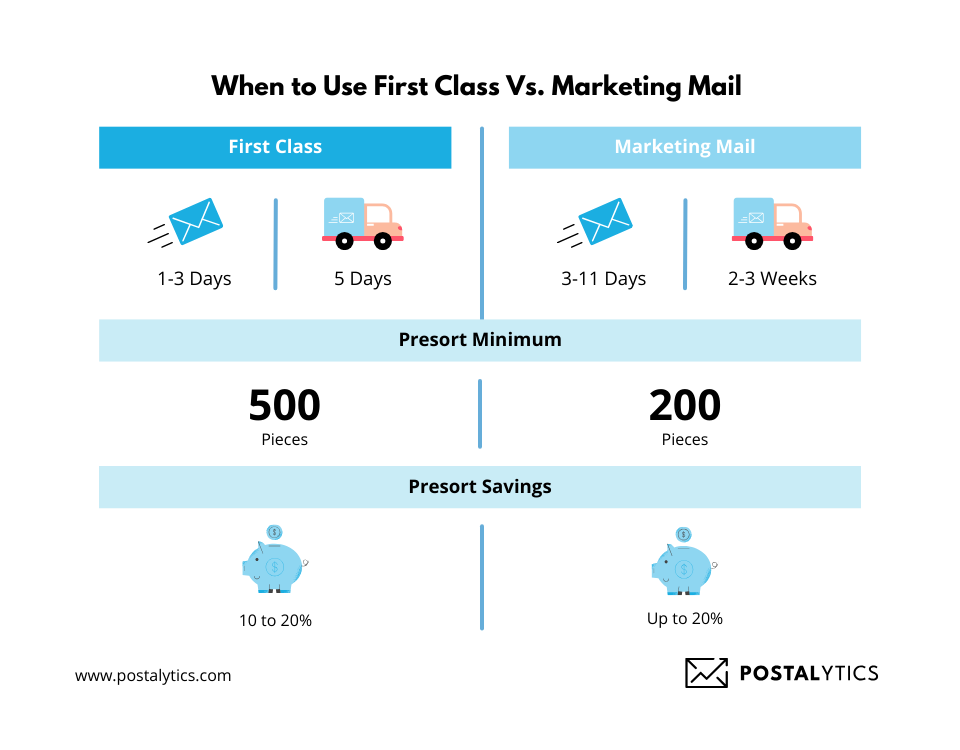![[POSTALYTICS] Marketing Mail vs First Class Mail](https://www.postalytics.com/wp-content/uploads/2024/09/POSTALYTICS-Marketing-Mail-vs-First-Class-Mail-1-1024x536.png)
One of the most crucial decisions you make in direct mail marketing is choosing the right postage. For our clients, this decision often boils down to two choices: First class or USPS Marketing Mail.
It’s a decision that guides both your costs and speed of delivery.
Which one should you choose then?
As a direct mail automation platform, we know postage like the back of our hand. In this article, we’ll help you understand the significance of these postage options, use cases, and which one to pick for your next direct mail campaign. Let’s get started.
What we’ll Cover:
- What is First-Class Mail?
- What is Marketing Mail?
- When to Use First Class Vs. Marketing Mail
- Create Effective First Class and Marketing Mail Campaigns With Postalytics
What is First-Class Mail?

First-Class Mail is a premium mailing service offered by the United States Postal Service (USPS) that prioritizes speed and reliability. It includes letters, postcards, and small packages weighing up to 13 ounces.
Delivery times typically range from one to five days within the U.S. First-Class Mail also provides added benefits, such as forwarding and return services if the recipient’s address changes.
Specifications for First-Class Mail
The size and weight requirements for different formats are:
- Postcards
| Minimum Size | 3½ inches by 5 inches |
| Maximum Size | 6 inches by 9 inches |
| Thickness | 0.007 inch to 0.016 inch |
| Weight | Up to 3.5 ounces |
- Letters
| Minimum Size | 3½ inches by 5 inches |
| Maximum Size | 6⅛ inches by 11½ inches |
| Thickness | 0.007 inch to 0.016 inch |
| Weight | Up to 3.5 ounces |
- Flats (Large envelopes)
| Minimum Size | 6⅛ inches by 11½ inches |
| Maximum Size | 12 inches by 15 inches |
| Thickness | ¼ inch to ¾ inch |
| Weight | Up to 13 ounces |
Benefits of First-Class Mail
First-Class Mail offers several key benefits for both individuals and businesses. One of the main advantages is its priority delivery, with letters and packages typically arriving within 1-5 business days across the U.S. This makes it ideal for sending time-sensitive materials like invoices, statements, or personal correspondence.
Additionally, First-Class priority mail is more affordable than other expedited mailing options, making it a cost-effective solution for reliable delivery. It also includes forwarding and return services, ensuring that undeliverable mail is either redirected or returned to the sender at no extra cost.
First-Class Mail also allows for the inclusion of important documents and packages weighing up to 13 ounces. It also has optional tracking and insurance services for added security. Businesses benefit from the ability to send personalized communications, such as direct mail pieces, that receive prioritized handling and delivery. Overall, First-Class Mail combines speed, affordability, and reliability, making it a valuable choice for various mailing needs.
Use Cases of First-Class Mail

Businesses use First-Class Mail for various purposes and campaigns. Here are a few of them.
- Invoices and billing statements: Ideal for sending important financial documents with priority delivery.
- Direct mail: Perfect for sending personalized marketing materials that require timely arrival.
- Legal documents: Reliable for sending time-sensitive contracts, notices, or official correspondence.
- Personal correspondence: Great for letters, invitations, and greeting cards that require quick delivery.
- Small packages: Useful for mailing items weighing up to 13 ounces, such as gifts or promotional samples.
- Subscription mail: Suitable for sending regular updates, newsletters, or membership cards to subscribers.
- Product returns: Used for returning small products with included tracking for secure delivery.
- Replacement parts: Efficient for sending urgent replacement parts or materials customers need.
What is Marketing Mail?
Marketing Mail (previously called Standard Mail) is a service offered by USPS designed for businesses sending bulk mailings at reduced rates. It is ideal for promotional materials, such as flyers, brochures, newsletters, and catalogs.
To qualify for Marketing Mail rates, items must meet specific size and weight requirements and be presorted by the sender. Unlike First-Class Mail, Marketing Mail is not prioritized for delivery, so it may take longer to reach recipients.
Specifications for Marketing Mail
For Marketing Mail, USPS does not follow a set of criteria for different formats. The maximum weight is 16 ounces, and the minimum quantity is 200 pieces or 50 pounds of mail.
Benefits of Marketing Mail
Marketing mail offers several benefits for businesses. One of the primary advantages is its lower postage rates, making it affordable for businesses to send large volumes of mail. These could be flyers, brochures, and catalogs. This is especially beneficial for direct mail campaigns that target specific geographic areas or demographics.
Marketing mail also provides flexibility in design and size options, allowing businesses to customize their mail pieces to suit their branding and messaging needs. Additionally, USPS offers advanced targeting options. It enables companies to reach their desired audience through Every Door Direct Mail (EDDM) or targeted mailing lists.
Another benefit is that businesses can take advantage of USPS’s presorting services, which helps reduce postage costs even further.
Use Cases of Marketing Mail

If you are looking for ways to use Marketing Mail, here are some use cases for inspiration.
- Direct mail advertising: Send promotional materials to large audiences at a low cost.
- Catalog distribution: Mail product catalogs to potential customers to showcase offerings and drive sales.
- Event invitations: Promote events, sales, or special offers to targeted demographics through bulk mailing.
- Nonprofit mailings: Reach donors and supporters with fundraising appeals or informational updates.
- Political campaigns: Distribute campaign materials, such as candidate profiles and voter reminders, during election season.
- Retail promotions: Notify local customers about in-store sales, coupons, or special promotions.
- Educational institutions: Send newsletters or program information to students, alums, and parents.
When to Use First Class Vs. Marketing Mail

Choosing between USPS Marketing Mail and First-Class Mail depends on your campaign goals, budget, and delivery timeline.
Opt for First-Class Mail when time and guaranteed delivery are priorities. It’s ideal for time-sensitive communications like invoices, bills, personal letters, and important notices. First-Class Mail is delivered within 1-5 business days, offers free forwarding, and includes return service for undeliverable mail. This option is best to ensure prompt delivery or track customer responses.
Opt for Marketing Mail for bulk promotional campaigns where cost efficiency is key. Marketing Mail is more affordable and designed for high-volume mailings such as flyers, postcards and event invitations. However, it takes longer to deliver—typically 3-10 business days. Marketing Mail does not include forwarding or return services unless purchased separately, making it more suitable for non-urgent, mass-marketing efforts.
In summary, choose First-Class Mail for urgent, personalized mailings and Marketing Mail for cost-effective, bulk distribution of promotional materials.
Create Effective First Class and Marketing Mail Campaigns With Postalytics
With Postalytics, creating effective First Class and Marketing Mail campaigns is simple. By integrating data-driven insights and automation, you can personalize each piece of mail for maximum impact.
Postalytics also makes it easy to track and analyze results, helping you optimize your campaigns for better performance. Whether you’re sending targeted direct mail or launching a large-scale marketing effort, Postalytics offers the tools and flexibility to ensure your campaigns are successful.
Connect with your customers by activating your free trial of Postalytics.
About the Author

Dennis Kelly
Dennis Kelly is CEO and co-founder of Postalytics. Dennis joined Boingnet, the predecessor to Postalytics, in 2013. Boingnet was focused on providing print and direct mail marketing service providers the ability to add digital marketing channels to their direct mail campaigns. Postalytics is Dennis’ 6th startup. He has been involved in starting and growing early-stage technology ventures for over 30 years and has held senior management roles at a diverse set of large technology firms including Computer Associates, Palm Inc. and Achieve Healthcare Information Systems.
